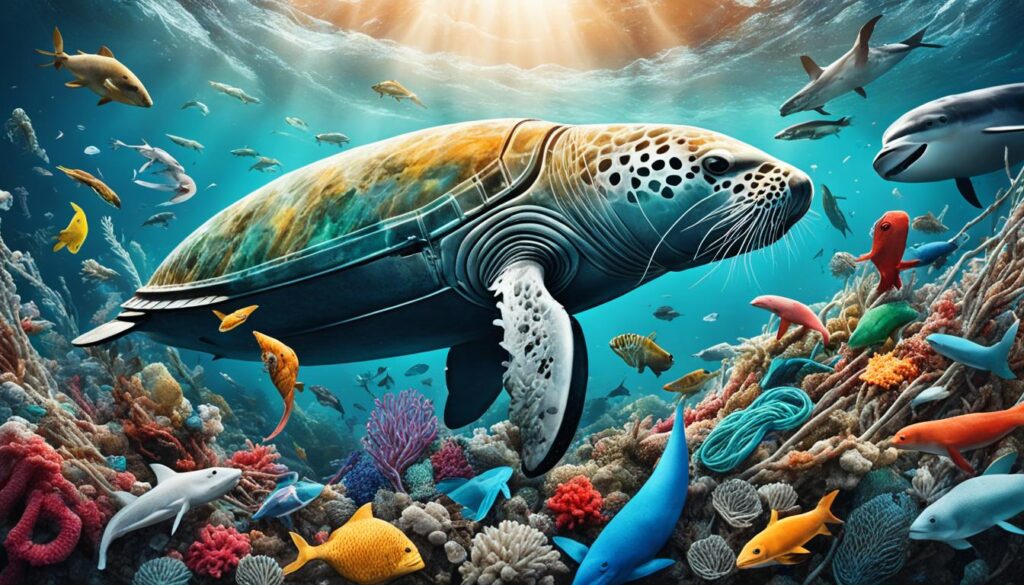The California Academy of Sciences has recently unveiled a groundbreaking exhibit that captures the attention of both marine enthusiasts and casual visitors alike. This extensive 4,100 square foot exhibit showcases the immense and captivating nature of whales, reflecting their critical role in marine biodiversity and how they serve as vital indicators of oceanic health.
Adorned with colossal whale skeletons and enriched with interactive, educational experiences, visitors are invited to explore the astonishing diversity of these ocean giants. The exhibit delves into their unique adaptations and chronicles the evolutionary journey of these magnificent creatures within marine ecosystems. This immersive experience not only highlights the extraordinary attributes of whales but also underscores the importance of marine life conservation.
Key Takeaways
- The California Academy of Sciences’ exhibit is a massive, 4,100 square foot display showcasing whale diversity.
- Whales play a crucial role in marine biodiversity and act as indicators of oceanic health.
- The exhibit features colossal whale skeletons and interactive educational experiences.
- Visitors can learn about the unique adaptations and evolutionary journey of marine mammals.
- This exhibit highlights the importance of marine life conservation.
The Fascinating World of Marine Mammals
Marine ecosystems are teeming with diverse life forms, and marine mammals hold a special place within these environments. Their unique adaptations for life in the water, remarkable in their variety, offer a glimpse into the incredible evolutionary journey these creatures have undertaken.
What Makes Marine Mammals Unique
Marine mammals are distinct from their terrestrial relatives in several ways that demonstrate their aquatic adaptation. For instance, many marine mammals have developed blubber to provide essential insulation against cold ocean waters. Additionally, their limbs have evolved into flippers, enhancing their ability to swim swiftly and efficiently. These adaptations are crucial for survival in their marine ecosystems.
Types of Marine Mammals
The diversity of marine mammals is astounding, encompassing a range of species from the massive blue whale to the small but agile Hector’s dolphin. Cetaceans, such as whales and dolphins, form one primary group, while pinnipeds, including seals, sea lions, and walruses, represent another. Finally, the sirenians, or sea cows, which include manatees and dugongs, round out this fascinating array of marine animal diversity.
| Group | Example Species | Unique Adaptations |
|---|---|---|
| Cetaceans | Blue Whale | Filter Feeding, Echo-Location |
| Pinnipeds | Sea Lion | Streamlined Body, Flipper-Like Limbs |
| Sirenians | Manatee | Herbivorous Diet, Paddle-Shaped Flippers |
Historical Significance of Whales
Throughout history, whales have held a remarkable place in many societies, forming an important facet of both human culture and marine ecosystems. The deep bond shared between humans and whales reveals an intricate tapestry of mutual respect and fascination.
Human Interaction Through the Ages
Since ancient times, the human-marine mammal interaction has profoundly influenced various cultures. Whales were revered, hunted, and mythologized by indigenous peoples across the world. The “Whales: Giants of the Deep” exhibit, for instance, showcases Maori artifacts that highlight the spiritual connection they shared with these majestic creatures. This human-marine mammal interaction is emblematic of both dependence and reverence.
Cultural Significance Across Societies
The cultural marine heritage associated with whales is diverse and rich. In South Pacific cultures, whales are often depicted in folklore, symbolizing strength, guidance, and protection. These marine mammals feature prominently in societal narratives, fostering a sense of identity and heritage. The blending of human and whale histories underlines the profound impact of these marine giants on cultural traditions and societal values.
Evolutionary Journey of Marine Mammals
The evolutionary journey of marine mammals showcases the fascinating transformation from terrestrial to aquatic lifestyles. This captivating transition highlights not only the resilience of these creatures but also their incredible adaptation to the challenges of marine environments.
From Land to Sea: The Evolutionary Path
Millions of years ago, ancestors of today’s marine mammals roamed the land. Through marine animal evolution, these species gradually migrated to the oceans, where they found abundant resources and fewer terrestrial predators. Key evolutionary steps included the streamlining of bodies and the development of flippers, enabling efficient swimming.
Adaptations for Aquatic Life
Marine mammal adaptation has led to a range of anatomical and physiological changes. For instance, the transformation of limbs into flippers facilitated more effective movement in water. Additionally, the development of blubber provides essential insulation and buoyancy in chilly ocean waters. Breathing adaptations, such as the ability to hold breath for extended periods, further illustrate these remarkable changes.
Notable Fossil Records
The fossil record is a profound testament to marine animal evolution. Fossils such as those of Ambulocetus, an early whale ancestor that lived around 50 million years ago, display the transitional features between land and marine mammals. These records offer vital insights into the evolutionary timeline and the morphological adaptations that have occurred.
| Era | Species | Key Adaptations |
|---|---|---|
| Eocene | Ambulocetus | Transition to semi-aquatic life, development of robust limbs |
| Oligocene | Basilosaurus | Streamlined body, fully aquatic |
| Miocene | Odontocetes | Enhanced echolocation abilities, complex social behaviors |
Sperm Whales: Giants Among Giants
The sperm whale holds the title of the largest toothed predator on our planet, an impressive feat given its role within marine ecosystems. These remarkable creatures can grow up to 58 feet in length, showcasing their dominance as marine megafauna within the deep-ocean biodiversity.
Highlighted for their unique characteristics, sperm whales feature a distinctive head structure, essential for their deep-diving capabilities. Their massive size and singular adaptations enable them to hunt and navigate the darkest depths of the ocean.
Sperm whales play a crucial role in maintaining the delicate balance of deep-ocean biodiversity. As apex predators, they not only regulate the populations of their prey but also contribute to the health of marine ecosystems. Studying these marine megafauna provides invaluable insights into the health and dynamics of oceanic environments.
One can’t discuss sperm whales without touching upon their social structures and intricate behaviors, which offer a glimpse into their sophisticated communication methods and hunting strategies. Understanding these behaviors is vital for conservation efforts and supports the broader goals of marine biodiversity preservation.
Understanding Whale Behaviors and Social Structures
Whales exhibit complex behaviors and social structures that are vital to their survival and communication. By studying these patterns, scientists gain valuable insights into the lives of these magnificent creatures.
Family Units and Pods
Whales are known to form intricate family units called pods. These pods are composed of related individuals that collaborate in their daily activities, displaying strong social bonds characteristic of social marine mammals. Within these pods, roles are clearly defined, ensuring effective coordination and mutual support. This structure enhances their ability to nurture young, protect each other from predators, and cooperate in hunting endeavors.
Communication and Echolocation
Marine communication among whales is remarkably sophisticated. Whales utilize a series of vocalizations, including clicks, whistles, and pulse calls, to convey messages within their pods. Echolocation, a type of marine communication, enables them to navigate murky ocean waters, locate prey, and maintain proximity to one another. This echolocation involves emitting sound waves that bounce off objects, helping whales form a mental map of their surroundings.
Feeding Habits and Hunting Strategies
Feeding habits and hunting strategies of whales are as varied as their species. Some employ cooperative techniques, such as bubble-net feeding, where a group creates bubbles to corral fish into a tighter area, making them easier to catch. Others, like the sperm whale, dive to great depths to hunt squids and other deep-sea creatures. These feeding strategies are influenced by their social structures and are critical to understanding overall whale behavior.
| Behavior Aspect | Details |
|---|---|
| Family Units | Pods of related individuals with defined roles |
| Communication | Vocalizations, including clicks and whistles |
| Echolocation | Sound wave emission for navigation and locating prey |
| Feeding Strategies | Techniques like bubble-net feeding and deep-sea diving |
Threats Faced by Marine Mammals
Marine mammals face a range of environmental threats that impact their survival and well-being. Addressing these threats is critical for oceanic preservation and ensuring the longevity of these majestic creatures.

Climate Change and Habitat Loss
Climate change significantly affects marine mammals, leading to habitat loss and altered ocean temperatures. These changes disrupt feeding patterns, breeding grounds, and migration routes, posing substantial marine conservation challenges.
Entanglement in Fishing Gear
Entanglement in fishing gear is a prevalent hazard for marine mammals. This issue not only causes physical injuries but can also lead to fatalities. Addressing this problem is crucial for effective oceanic preservation.
Pollution and Ship Strikes
Pollution, ranging from chemical contaminants to plastic debris, poses severe threats to marine mammals. Additionally, ship strikes result in numerous injuries and deaths each year, further complicating marine conservation efforts. Mitigating these environmental threats is vital for safeguarding marine biodiversity.
Marine Mammals: Indicators of Ocean Health
Marine mammals play a crucial role in maintaining the health of our oceans. They reflect changes in environmental conditions, making them vital bioindicator species.
The Role of Marine Mammals in Ecosystems
Marine mammals contribute significantly to ocean health by maintaining balanced ecosystems. Their presence affects prey populations and nutrient distribution, ensuring the ecosystem remains resilient and healthy.
Marine Mammals as Bioindicators
Bioindicator species, such as marine mammals, provide critical information about the state of the ocean. Changes in their behavior, population numbers, and health can signal shifts in environmental conditions, acting as early warnings for potential ecological issues.
Conservation Efforts and Technological Advances
Marine mammal conservation is a priority for many organizations, with efforts focusing on protecting and preserving these essential species. Technological advancements, such as satellite tracking and genetic research, combined with citizen science initiatives, have enhanced our ability to monitor and support marine mammal populations effectively.
| Effort | Description | Impact |
|---|---|---|
| Satellite Tracking | Uses satellites to monitor movements and migration patterns. | Improves understanding of habitat needs and threats. |
| Genetic Research | Analyzes DNA to study species diversity and health. | Identifies critical areas for marine mammal conservation. |
| Citizen Science | Engages the public in data collection and observation. | Increases data availability and public awareness. |
Exploring the Depths: Oceanography and Marine Mammals
Deep-sea exploration has revolutionized our understanding of marine environments, particularly in relation to marine mammals. With advancements in oceanographic research, scientists are uncovering previously unknown marine life and gaining deeper insights into the lives of these magnificent creatures.
Recent breakthroughs in underwater technology have significantly enhanced our capacity to explore and study deep-sea ecosystems. These technological advancements have led to the discovery of new species, revealing the rich biodiversity that exists in the ocean’s depths.
Researchers are now able to observe marine mammals in their natural habitats, providing critical data on their behaviors and interactions. This knowledge is vital for the preservation and conservation of these species, as it helps in understanding the impacts of human activities on marine life.
Further, the implementation of remote-operated vehicles (ROVs) and autonomous underwater vehicles (AUVs) has expanded the scope of oceanographic research, allowing scientists to reach previously inaccessible areas. These tools are essential for collecting samples and data from the deep ocean, providing a clearer picture of the complex ecosystems in which marine mammals thrive.
Conclusion
To sum up, the intricate relationship between marine mammals and human societies underscores the necessity of sustainable ocean interactions. These majestic creatures, from the mighty sperm whales to the enigmatic dolphins, play an indispensable role in maintaining the balance of marine ecosystems. Their behaviors, social structures, and evolutionary adaptations are not only fascinating but also serve as crucial indicators of ocean health.
As we look to the future of marine mammals, it becomes abundantly clear that our actions today will shape their fate tomorrow. The historical significance and cultural importance of these animals highlight our interconnectedness and shared responsibility. By deploying urban initiatives and advancing technological innovations, we can foster an environment where both marine mammals and human populations thrive in harmony.
The legacy of marine conservation is a clarion call for action. It urges us to protect the remarkable diversity and vital ecological role of these giants of the deep. Embracing a holistic approach to ocean stewardship will ensure that the next generations inherit a vibrant and healthy marine world, where sustainable interactions with our oceans become the cornerstone of our environmental ethos.











